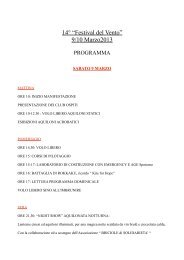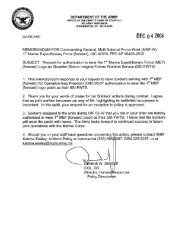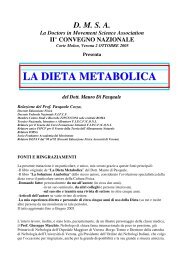- Page 2:
SCIENCE VS. RELIGION
- Page 6:
SCIENCE VS. RELIGIONWhat Scientists
- Page 10:
to Karl
- Page 14:
CONTENTSPrefaceixPART ICrossing the
- Page 20:
xPREFACEdie out if they do not lear
- Page 24:
This page intentionally left blank
- Page 28:
This page intentionally left blank
- Page 32:
4Crossing the Picket Lines: The Per
- Page 36:
6Crossing the Picket Lines: The Per
- Page 40:
8Crossing the Picket Lines: The Per
- Page 44:
10Crossing the Picket Lines: The Pe
- Page 48:
12Crossing the Picket Lines: The Pe
- Page 52:
14Crossing the Picket Lines: The Pe
- Page 56:
16Crossing the Picket Lines: The Pe
- Page 60:
18Crossing the Picket Lines: The Pe
- Page 64:
20Crossing the Picket Lines: The Pe
- Page 68:
22Crossing the Picket Lines: The Pe
- Page 72:
24Crossing the Picket Lines: The Pe
- Page 76:
26Crossing the Picket Lines: The Pe
- Page 80:
This page intentionally left blank
- Page 84:
30Crossing the Picket Lines: The Pe
- Page 88:
32Crossing the Picket Lines: The Pe
- Page 92:
34Crossing the Picket Lines: The Pe
- Page 96:
36Crossing the Picket Lines: The Pe
- Page 100:
38Crossing the Picket Lines: The Pe
- Page 104:
40Crossing the Picket Lines: The Pe
- Page 108:
42Crossing the Picket Lines: The Pe
- Page 112:
44Crossing the Picket Lines: The Pe
- Page 116:
46Crossing the Picket Lines: The Pe
- Page 120:
48Crossing the Picket Lines: The Pe
- Page 124:
50Crossing the Picket Lines: The Pe
- Page 128:
52Crossing the Picket Lines: The Pe
- Page 132:
54Crossing the Picket Lines: The Pe
- Page 136:
56Crossing the Picket Lines: The Pe
- Page 140:
58Crossing the Picket Lines: The Pe
- Page 144:
60Crossing the Picket Lines: The Pe
- Page 148: 62Crossing the Picket Lines: The Pe
- Page 152: 64Crossing the Picket Lines: The Pe
- Page 156: 66Crossing the Picket Lines: The Pe
- Page 160: 68Crossing the Picket Lines: The Pe
- Page 164: This page intentionally left blank
- Page 168: 72Society and Broader Publicsinstea
- Page 172: 74Society and Broader Publicssome o
- Page 176: 76Society and Broader Publicsreligi
- Page 180: 78Society and Broader Publicsfor re
- Page 184: 80Society and Broader PublicsFor al
- Page 188: 82Society and Broader Publicsthem a
- Page 192: 84Society and Broader Publicsfrom r
- Page 196: 86Society and Broader Publicshere?
- Page 202: No God on the Quad 89But change is
- Page 206: No God on the Quad 91their universi
- Page 210: No God on the Quad 93THE MODEL OF O
- Page 214: No God on the Quad 95were religious
- Page 218: No God on the Quad 97other professi
- Page 222: No God on the Quad 99THE MODEL OF P
- Page 226: No God on the Quad 101quiet about h
- Page 230: No God on the Quad 103You can talk
- Page 234: No God on the Quad 105you would try
- Page 238: CHAPTER 7God on the QuadMaking Room
- Page 242: God on the Quad 109to a “man of t
- Page 246: God on the Quad 111students in thei
- Page 250:
God on the Quad 113about these conn
- Page 254:
God on the Quad 115perspectives on
- Page 258:
God on the Quad 117of natural scien
- Page 262:
God on the Quad 119As discussed in
- Page 266:
God on the Quad 121an important par
- Page 270:
God on the Quad 123this does little
- Page 274:
God on the Quad 125Is there room fo
- Page 278:
CHAPTER 8What Scientists Are Doing
- Page 282:
What Scientists Are Doing Wrong Tha
- Page 286:
What Scientists Are Doing Wrong Tha
- Page 290:
What Scientists Are Doing Wrong Tha
- Page 294:
What Scientists Are Doing Wrong Tha
- Page 298:
What Scientists Are Doing Wrong Tha
- Page 302:
What Scientists Are Doing Wrong Tha
- Page 306:
What Scientists Are Doing Wrong Tha
- Page 310:
What Scientists Are Doing Wrong Tha
- Page 314:
What Scientists Are Doing Wrong Tha
- Page 318:
What Scientists Are Doing Wrong Tha
- Page 322:
CHAPTER 9Shattering Myths, Toward D
- Page 326:
Shattering Myths, Toward Dialogue 1
- Page 330:
Shattering Myths, Toward Dialogue 1
- Page 334:
Shattering Myths, Toward Dialogue 1
- Page 338:
APPENDIX AThe StudyThe data for Sci
- Page 342:
APPENDIX A 159immortality, and desi
- Page 346:
APPENDIX A 161As economists and pol
- Page 350:
% Hispanic .9 1.0 1.8 1.3 4.6 3.5 5
- Page 354:
APPENDIX A 165transcript was not co
- Page 358:
APPENDIX BWeb and Phone SurveyThank
- Page 362:
APPENDIX B 1696) Other spiritual ex
- Page 366:
APPENDIX B 1714) Other, IS THAT —
- Page 370:
APPENDIX B 17315. For classificatio
- Page 374:
APPENDIX B 175evangelical, mainline
- Page 378:
APPENDIX B 1773) Rarely4) Never5) N
- Page 382:
APPENDIX B 17930b. (before tax and
- Page 386:
APPENDIX CLong Interview GuideACADE
- Page 390:
APPENDIX C 18314. As a child, were
- Page 394:
NOTESChapter 11. I have chosen two
- Page 398:
NOTES TO PAGES 7-1118716. See the N
- Page 402:
NOTES TO PAGES 19-20189such as natu
- Page 406:
NOTES TO PAGES 24-3319129. Bio 2, c
- Page 410:
NOTES TO PAGES 36-43193(such as mar
- Page 414:
NOTES TO PAGES 51-56195N=1217) equa
- Page 418:
NOTES TO PAGES 59-65197had an impor
- Page 422:
NOTES TO PAGES 71-81199Chapter 51.
- Page 426:
NOTES TO PAGES 88-922017. See Smith
- Page 430:
NOTES TO PAGES 95-10820332. Soc 26,
- Page 434:
NOTES TO PAGES 113-12520521. Bio 13
- Page 438:
NOTES TO PAGES 133-14320714. For mo
- Page 442:
NOTES TO PAGES 151-1582095. Chem 18
- Page 446:
BIBLIOGRAPHYAlexander, Denis R. 200
- Page 450:
BIBLIOGRAPHY 213Cadge, Wendy, and E
- Page 454:
BIBLIOGRAPHY 215Foss, Edward. 1999.
- Page 458:
BIBLIOGRAPHY 217Kuhn, Thomas S. 199
- Page 462:
BIBLIOGRAPHY 219Newberg, Andrew, Eu
- Page 466:
BIBLIOGRAPHY 221Smith, Christian, M
- Page 470:
INDEXadolescent struggles, of scien
- Page 474:
INDEX 225history, of conflict parad
- Page 478:
INDEX 227religious engagement, of s
















